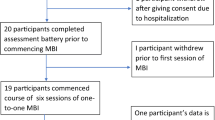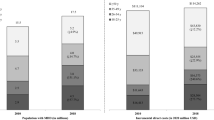Abstract
Despite the considerable amount of research that has been undertaken on poststroke depression, a review of the literature demonstrates that there are many inconclusive findings in the area. In particular, the causes and course of the disorder remain to be firmly established. While studies of prevalence differ with respect to the nature and timing of their assessment procedures, most conclude that poststroke depression has a negative impact on the rehabilitation of the stroke patient. Very little research is available on the relationship between poststroke depression and care-giver burden. However, recent studies have adopted more rigorous methodological procedures, allowing some insights into the complex mixture of factors which determine the occurrence of poststroke depression.
Similar content being viewed by others
References
Agrell, B., and Dehlin, O. (1989). Comparison of six depression rating scales in geriatric stroke patients.Stroke 20: 1190–1194.
Allman, P., Hope, T., and Fairburn, C. G. (1992). Crying following stroke: A report on 30 cases.General Hospital Psychiatry 14: 315–321.
Andersen, G., Vestergaard, K., and Lauritzen, L. (1994). Effective treatment of poststroke depression with the selective serotonin reuptake inhibitor citalopram.Stroke 25: 1099–1104.
Andersen, G., Vestergaard, K., and Riis, J. O. (1993). Citalopram for post-stroke pathological crying.Lancet 342: 837–839.
Andersen, G., Vestergaard, K., Riis, J. O., and Lauritzen, L. (1994). Incidence of post-stroke depression during the first year in a large unselected stroke population determined using a valid standardized rating scale.ACTA Psychiatrica Scandinavica 90: 190–195.
Anderson, R. (1992).The Aftermath of Stroke: The Experience of Patients and Their Families, Cambridge University Press, Cambridge.
Angeleri, F., Angeleri, V. A., Foschi, N., Giaquinto, S., and Nolfe, G. (1993). The influence of depression, social activity, and family stress on functional outcome after stroke.Stroke 24: 1478–1483.
Antonuccio, D. O., Danton, W. G., and DeNelsky, G. Y. (1995). Psychotherapy versus medication for depression: Challenging the conventional wisdom with data.Professional Psychology: Research and Practice 26: 574–585.
Astrom, M., Adolfsson, R., and Asplund, K. (1993). Major depression in stroke patients: A 3-year longitudinal study.Stroke 24: 976–982.
Astrom, M., Asplund, K., and Astrom, T. (1992). Psychosocial function and life satisfaction after stroke.Stroke 23: 527–531.
Astrom, M., Olsson, T., and Asplund, K. (1993). Different linkage of depression to hypercortisolism early versus late after stroke: A 3-year longitudinal study.Stroke 24: 52–57.
Barry, S., Phillips, O. M., Williams, D. S., and Dinan, T. G. (1990). Platelet 5-HT uptake in post-stroke depression.ACTA Psychiatrica Scandinavica 82: 88–89.
Burke, W. J., Nitcher, R. L., Roccaforte, W. H., and Wengel, S. P. (1992). A prospective evaluation of the Geriatric Depression Scale in an outpatient geriatric assessment center.Journal of the American Geriatrics Society 40: 1227–1230.
Davison, G. C., and Neale, J. M. (1990).Abnormal Psychology (5th ed.), John Wiley and Sons, New York.
Draper, B. M., Poulos, C. J., Cole, A. M. D., Poulos, R. G., and Ehrlich, F. (1992). A comparison of caregivers for elderly stroke and dementia victims.Journal of the American Geriatric Society 40: 896–901.
Falconer, J. A., Naughton, B. J., Strasser, D. C., and Sinacore, J. M. (1994). Stroke inpatient rehabilitation: A comparison across age groups.Journal of the American Geriatric Society 42: 39–44.
Fedoroff, J. P., Starkstein, S. E., Parikh, R. M., Price, T. R., and Robinson, R. G. (1991). Are depressive symptoms nonspecific in patients with acute stroke?.American Journal of Psychiatry 48: 1172–1176.
Fischer, J., and Corcoran, K. (1994).Measures for Clinical Practice: A Sourcebook (2nd ed.), Free Press, New York.
Gainotti, G. (1992). Post-stroke depression: Psychological and biochemical interpretations. In von Steinbuchel, N., van Cramon, D. Y., and Poppel, E. (eds.),Neuropsychological Rehabilitation, Springer-Verlag, New York, pp. 215–225.
Gass, C. S., and Lawhorn, L. (1991). Psychological adjustment following stroke: An MMPI study.Psychological Assessment 3: 628–633.
Gladman, J. R. F., Lincoln, N. B., and Barer, D. H. (1993). A randomised controlled trial of domiciliary and hospital-based rehabilitation for stroke patients after discharge from hospital.Journal of Neurology, Neurosurgery, and Psychiatry 56: 960–966.
Gompertz, P., Pound, P., and Ebrahim, S. (1993). The reliability of stroke outcome measures.Clinical Rehabilitation 7: 290–296.
Grasso, M. G., Pantano, P., Ricci, M., Intiso, D. F., Pace, A., Padovani, A., Orzi, F., Prozzilli, C., and Lenzi, G. L. (1994). Mesial temporal cortex hypoperfusion is associated with depression in subcortical stroke.Stroke 25: 980–985.
Greveson, G. C., Gray, C. S., French, J. M., and James, O. F. W. (1991). Long-term outcome for patients and carers following hospital admission for stroke.Age and Ageing 20: 337–344.
Haley, W. E., Levine, E. G., Brown, S. L., and Bartolucci, A. A. (1987). Stress, appraisal, coping and social support as predictors of adaptational outcome among dementia caregivers.Psychology and Aging 2: 323–330.
Heilman, K. M., Bowers, D., and Valenstein, E. (1993). Emotional disorders associated with neurological diseases. In Heilman, K. M., and Valenstein, E. (eds.),Clinical Neuropsychology, Oxford University Press, New York, pp. 461–497.
Herrmann, M., Bartels, C., Schumacher, M., and Wallesch, C. (1995). Poststroke depression: Is there a pathoanatomic correlate for depression in the postacute stage of stroke?Stroke 26: 850–856.
Herrmann, M., Bartels, C., and Wallesch, C. W. (1993). Depression in acute and chronic aphasia: Symptoms, pathoanatomical-clinical correlations and functional implications.Journal of Neurology, Neurosurgery, and Psychiatry 56: 672–678.
House, A., Dennis, M., Mogridge, L., Warlow, C., Hawton, K., and Jones, L. (1991). Mood disorders in the year after first stroke.British Journal of Psychiatry 158: 83–92.
Jacobson, N. S., and Hollon, S. D. (1996). Prospects for future comparisons between drugs and psychotherapy: Lessons from the CBT-versus-pharmacotherapy exchange.Journal of Consulting and Clinical Psychology 64: 104–108.
Johnson, G. A. (1991). Research into psychiatric disorder after stroke: The need for further studies.Australian and New Zealand Journal of Psychiatry 25: 358–370.
Kelly-Hayes, M., and Paige, C. (1995). Assessment and psychologic factors in stroke rehabilitation.Neurology 45 (Suppl. 1): S29-S32.
Larner, S. L., and Leeming, J. T. (1984). The work of a clinical psychologist in the care of the elderly.Age and Ageing 13: 29–33.
Lazarus, L. W., Moberg, P. J., Langsley, P. R., and Lingam, V. R. (1994). Methylphenidate and nortriptyline in the treatment of poststroke depression: A retrospective comparison.Archives of Physical and Medical Rehabilitation 75: 403–406.
Lezak, M. D. (1995).Neuropschological assessment (3rd ed.). Oxford, New York.
McDowell, I., and Newell, C. (1987).Measuring Health: A Guide to Rating Scales and Questionnaires, Oxford, New York.
McGivney, S. A., Mulvihill, M., and Taylor, B. (1994). Validating the GDS depression screen in the nursing home.Journal of the American Geriatric Society 42: 490–492.
Morris, P. L. P., Raphael, B., and Robinson, R. G. (1992). Clinical depression is associated with impaired recovery from stroke.The Medical Journal of Australia 157: 239–242.
Morris, P. L. P., Robinson, R. G., Andrzejewski, P., Samuels, J., and Price, T. R. (1993). Association of depression with 10-year poststroke mortality.American Journal of Psychiatry 150: 124–129.
Morris, P. L. P., Robinson, R. G., and Samuels, J. (1993). Depression, introversion and mortality following stroke.Australian and New Zealand Journal of Psychiatry 27: 443–449.
Morris, P. L. P., Robinson, R. G., and Raphael, B. (1993). Emotional lability after strokeAustralian and New Zealand Journal of Psychiatry 27: 601–605.
Morris, P. L. P., Robinson, R. G., Raphael, B., Samuels, J., and Molloy, P. (1992). The relationship between risk factors for affective disorder and poststroke depression in hospitalized stroke patients.Australian and New Zealand Journal of Psychiatry 26: 208–217.
Mullen, P. E., Linsell, C. R., and Parker, D. (1986). Influence of sleep disruption and calorie restriction on biological markers for depression.Lancet ii: 1051–1056.
Nelson, L. D., Cicchetti, D., Satz, P., Sowa, M., and Mitrushina, M. (1994). Emotional sequelae of stroke: A longitudinal perspective.Journal of Clinical and Experimental Neuropsychology 16: 796–806.
Norman, T. R., Judd, F. K., and Burrows, G. D. (1992). New pharmacological approaches to the management of depression: From theory to clinical practice.Australian and New Zealand Journal of Psychiatry 26: 73–81.
Parikh, R. M., Lipsey, J. R., Robinson, R. G., and Price, T. R. (1987). Two-year longitudinal study of post-stroke mood disorders: Dynamic changes in correlates of depression at one and two years.Stroke 18: 579–584.
Parikh, R. M., Robinson, R. G., Lipsey, J. R., Starkstein, S. E., Fedoroff, J. P., and Price, T. R. (1990). The impact of poststroke depression on recovery in activities of daily living over a 2-year follow-up.Archives of Neurology 47: 785–789.
Price, T. R. (1990). Affective disorders after stroke.Stroke 21: 12–13.
Rehm, L. P. (1988). Assessment of depression. In A. S. Bellack, and M. Hersen (eds.),Behavioral Assessment: A Practical Handbook (3rd ed.), Pergamon Press, New York, pp. 313–364.
Robinson, R. G., Bolduc, P. L., and Price, T. R. (1987). A two-year longitudinal study of post-stroke mood disorders: Diagnosis and outcome at one and two years.Stroke 18: 837–843.
Robinson, R. G., and Price, T. R. (1982). Post-stroke depressive disorders: A follow-up study of 103 patients.Stroke 13: 635–641.
Robinson, R. G., Starr, L. B., Kubos, K. L., and Price, T. R. (1983). A two-year longitudinal study of post-stroke mood disorders: Findings during the initial evaluation.Stroke 14: 736–741.
Robinson, R. G., Starr, L. B., Lipsey, J. R., Rao, K., and Price, T. R. (1984). A two-year longitudinal study of post-stroke mood disorders: Dynamic changes in associated variables over the first six months of follow-up.Stroke 15: 510–517.
Robinson, R. G., Starr, L. B., and Price, T. R. (1984). A two-year longitudinal study of mood disorders following stroke: Prevalence and duration at six months follow-up.British Journal of Psychiatry 144: 256–262.
Sandin, K. J., Cifu, D. X., and Noll, S. F. (1994). Stroke rehabilitation 4: Psychologic and social implications.Archives of Physical and Medical Rehabilitation 75: S52-S55.
Schubert, D. S. P., Burns, R., Paras, W., and Sioson, E. (1992). Decrease of depression during stroke and amputation rehabilitation.General Hospital Psychiatry 14: 135–141.
Schubert, D. S. P., Taylor, D., Lee, D. O. S., Mentari, A., and Tamaklo, W. (1992). Physical consequences of depression in the stroke patients.General Hospital Psychiatry 14: 69–76.
Schwartz, J. A., Speed, N. M., Mountz, J. M., Gross, M. D., Dell, J. G., and Kuhl, D. E. (1990).99mTc-Hexamethylpropyleneamine oxime single photon emission CT in poststroke depression.American Journal of Psychiatry 147: 242–244.
Sharpe, M., Hawton, K., Seagroatt, V., Bamford, J., House, A., Molyneux, A., Sandercock, P., and Warlow, C. (1994). Depressive disorders in long-term survivors of stroke: Associations with demographic and social factors, functional status, and brain lesion volume.British Journal of Psychiatry 164: 380–386.
Shaver, P. R., and Brennan, K. A. (1991). Measures of depression and loneliness. In J. P. Robinson, P. R. Shaver, and L. S. Wrightsman (eds.).Measures of Personality and Social Psychological Attitudes, Academic Press, San Diego, CA.
Shima, S., Kitagawa, Y., Kitamura, T., Fujinawa, A., and Watanabe, Y. (1994). Poststroke depression.General Hospital Psychiatry 16: 286–289.
Skilbeck, C. (1992). Neuropsychological assessment in stroke. In Crawford, J. R., Parker, D. M., and McKinlay, W. W. (eds.),A Handbook of Neuropsychological Assessment, Lawrence Erlbaum, Hove, UK, pp. 339–361.
Sloan, R. L., Brown, K. W., and Pentland, B. (1992). Fluoxetine as a treatment for emotional lability after brain injury.Brain Injury 6: 315–319.
Starkstein, S. E., Cohen, B. S., Fedoroff, P., Parikh, R. M., Price, T. R., and Robinson, R. G. (1990). Relationship between anxiety disorders and depressive disorders in patients with cerebrovascular injury.Archives of General Psychiatry 47: 246–251.
Stern, R. A., and Bachman, D. L. (1991). Depressive symptoms following stroke.American Journal of Psychiatry 148: 351–356.
Tatemichi, T. K., Desmond, D. W., Stern, Y., Paik, M., Sano, M., and Bagiella, E. (1994). Cognitive impairment after stroke: Frequency, patterns, and relationship to functional abilities.Journal of Neurology, Neurosurgery, and Psychiatry, 57: 202–207.
Thompson, S. C., Bundek, N. I., and Sobolew-Shubin, A. (1990). The caregivers of stroke patients: An investigation of factors associated with depression.Journal of Applied Social Psychology 20: 115–129.
Tyman, R. V. (1994). The stress experienced by caregivers of stroke survivors: Is it all in the mind, or is it also in the body?Clinical Rehabilitation 8: 341–345.
Yamaguchi, S., Kobayashi, S., Koide, H. and Tsunematsu, T. (1992). Longitudinal study of regional cerebral blood flow changes in depression after stroke.Stroke 23: 1716–1722.
Author information
Authors and Affiliations
Rights and permissions
About this article
Cite this article
Hosking, S.G., Marsh, N.V. & Friedman, P.J. Poststroke depression: Prevalence, course, and associated factors. Neuropsychol Rev 6, 107–133 (1996). https://doi.org/10.1007/BF01874894
Issue Date:
DOI: https://doi.org/10.1007/BF01874894




